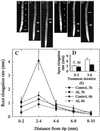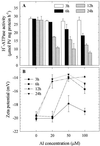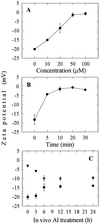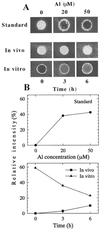Aluminum inhibits the H(+)-ATPase activity by permanently altering the plasma membrane surface potentials in squash roots
- PMID: 11500538
- PMCID: PMC117139
- DOI: 10.1104/pp.126.4.1381
Aluminum inhibits the H(+)-ATPase activity by permanently altering the plasma membrane surface potentials in squash roots
Abstract
Although aluminum (AL) toxicity has been widely studied in monocotyledonous crop plants, the mechanism of Al impact on economically important dicotyledonous plants is poorly understood. Here, we report the spatial pattern of Al-induced root growth inhibition, which is closely associated with inhibition of H(+)-ATPase activity coupled with decreased surface negativity of plasma membrane (PM) vesicles isolated from apical 5-mm root segments of squash (Cucurbita pepo L. cv Tetsukabuto) plants. High-sensitivity growth measurements indicated that the central elongation zone, located 2 to 4 mm from the tip, was preferentially inhibited where high Al accumulation was found. The highest positive shifts (depolarization) in zeta potential of the isolated PM vesicles from 0- to 5-mm regions of Al-treated roots were corresponded to pronounced inhibition of H(+)-ATPase activity. The depolarization of PM vesicles isolated from Al-treated roots in response to added Al in vitro was less than that of control roots, suggesting, particularly in the first 5-mm root apex, a tight Al binding to PM target sites or irreversible alteration of PM properties upon Al treatment to intact plants. In line with these data, immunolocalization of H(+)-ATPase revealed decreases in tissue-specific H(+)-ATPase in the epidermal and cortex cells (2--3 mm from tip) following Al treatments. Our report provides the first circumstantial evidence for a zone-specific depolarization of PM surface potential coupled with inhibition of H(+)-ATPase activity. These effects may indicate a direct Al interaction with H(+)-ATPase from the cytoplasmic side of the PM.
Figures







References
-
- Ahn SJ, Im YJ, Chung GC, Cho BH. Inducible expression of plasma membrane H+-ATPase in the roots of figleaf gourd plants under chilling root temperature. Physiol Plant. 1999;106:35–40.
-
- Bradford MM. A rapid and sensitive method for the quantitation of microgram quantities of protein utilizing the principle of protein-dye binding. Anal Biochem. 1976;72:248–254. - PubMed
-
- Gimmler H, Treffny B, Kowalski M, Zimmermann U. The resistance of Dunaliella acidophila against heavy metals: the importance of the zeta potential. J Plant Physiol. 1991;138:708–716.
-
- Horst WJ. The role of the apoplast in aluminum toxicity and resistance of higher plants: a review. Z Pflanzenernäehr Bodenkd. 1995;158:419–428.
Publication types
MeSH terms
Substances
LinkOut - more resources
Full Text Sources
Miscellaneous

